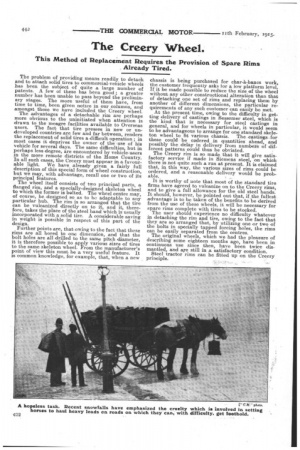The Creery Wheel.
Page 16

If you've noticed an error in this article please click here to report it so we can fix it.
This Method of Replaceinent Requires the Provision of Spare Rims Already Tired.
The problem of providing means readily to detach and to attach solid tires to commercial-vehicle wheels has been the subject of quite a large number of patents. A few of these has been good ; a greater number has been unable to pass beyond the preliminary stages. The more useful of them have, from time to time, been given notice in our columns, and amongst these we have included the Creery wheel. The advantages of a detachable rim are perhaps more obvious to the uninitiated when attention is drawn to the meagre facilities available to Overseas users. The fact that tire presses in new or undeveloped countries are few and far between, renders the replacement of solid tires a difficult operation ; in most cases it deprives the owner of the use of his vehicle for several days. The same difficulties, but in perhaps less degree, are encountered by vehicle-users in the more remote districts of the Home Country. In all such cases, the Creery must appear in a favourable light. We have already given a fairly full description of this special form of wheel construction, but we may, with advantage, recall one or two of its principal features. The wheel itself consists of two principal parts, a flanged rim, and a specially-designed skeleton wheel to which the former is bolted. The wheel centre may, of course, be designed so as to be adaptable to any particular hub. The rim is so arranged that the tire can be vulcanized directly on to it, and it, therefore, takes the place of the steel band which is usually incorporated with a solid tire. A considerable saving in weight is possible in respect of this part of the design. Further points are, that owing to the fact that these rims are all bored to one dimension, and that the bolt holes are all drilled to the same pitch diameter, it is therefore possible to apply various sizes of tires to the same skeleton wheel. From the manufacturer's point of view this must be a very useful feature. It is common knowledge, for example, that, when a new chassis is being purchased for char-k-bancs work, the customer frequently asks for a low platform level. If it be made possible to reduce the size of the wheel without any other constructional alteration than that of detaching one set of rims and replacing them by another of different dimensions, the particular requiremextts of any such customer can easily be met. At the present time, owing to the difficulty in getting delivery of castings in Bessemer steel, which is the kind that is necessary for steel castings in general, and for wheels in particular, it would seem to be advantageous to arrange for one standard skeleton wheel to fit various chassis. The castings for these could be ordered in quantities ahead, and possibly the delay in delivery from numbers of different patterns could thus be obviated. The Creery rim is so made that it will give satisfactory service if made in Siemens steel, on which there is not quite such a run at present. It is claimed that, in this way, the various sizes of rims could be ordered, and a reasonable delivery would be probable.
It is worthy of note that most of the standard tire firms have agreed to vulcanize on to the Creery rims, and to give a full allowance for the old steel bands. It should, however, be pointed out that, if the fullest advantage is to be taken of the benefits to be derived from the use of these wheels, it will be necessary for spare rims complete with tires to be stocked. The user should experience no difficulty whatever in detaching the rim and tire, owing to the fact that they are so arranged that, by utilizing one or two of the bolts in specially tapped forcing holes, the rims can be easily separated from the centres. The original wheels, which we had the pleasure of describing some eighteen months ago, have been in continuous use since then, have been twice dismantled, and ape still in a satisfactory condition. Steel tractor rims can be fitted up on the Creery principle.






















